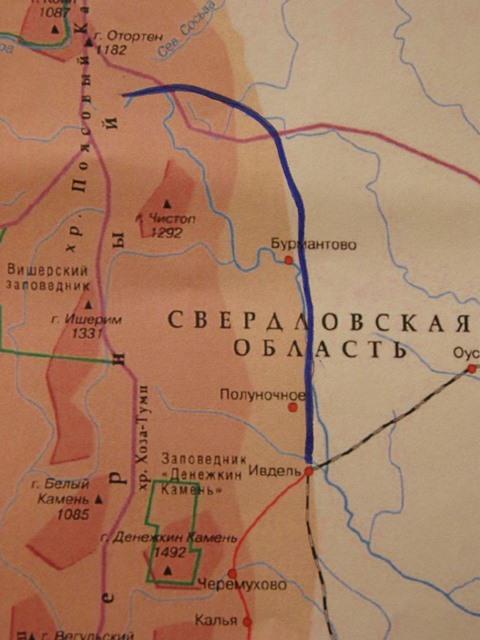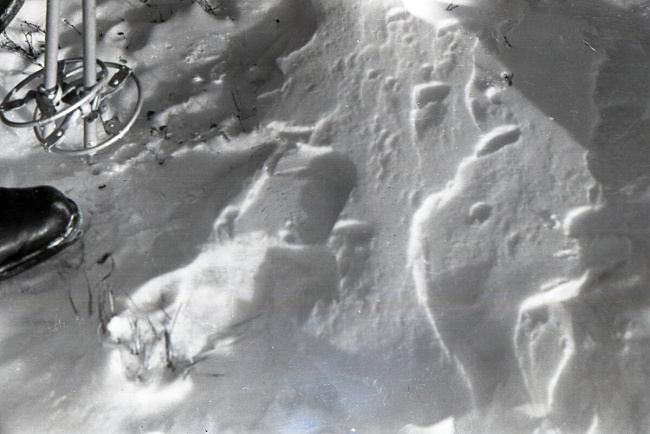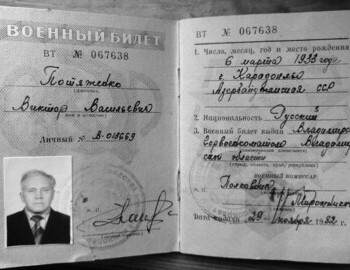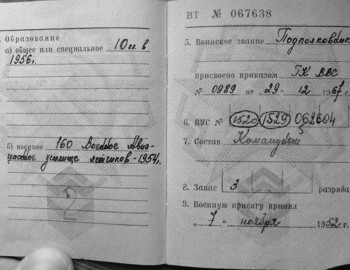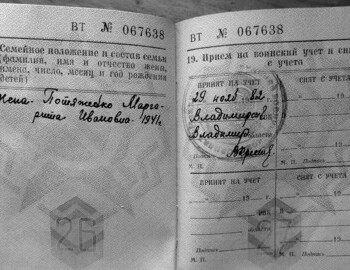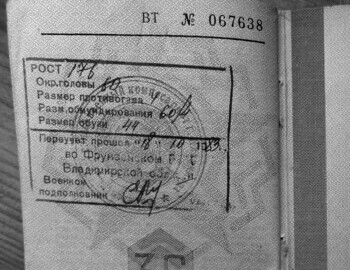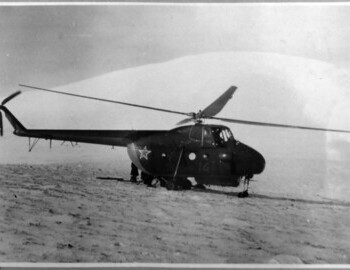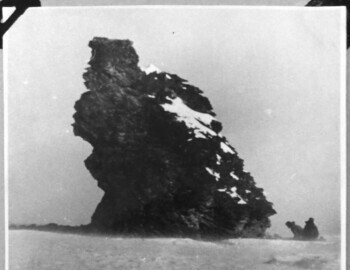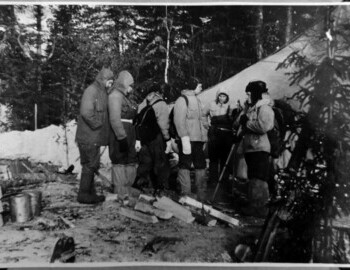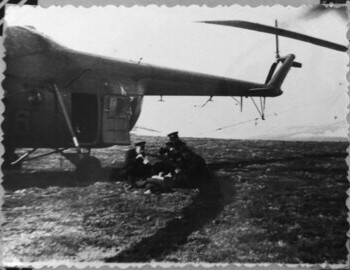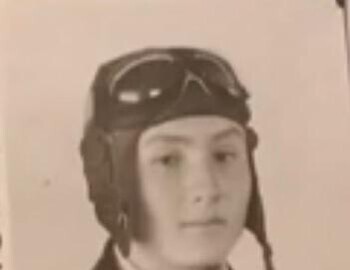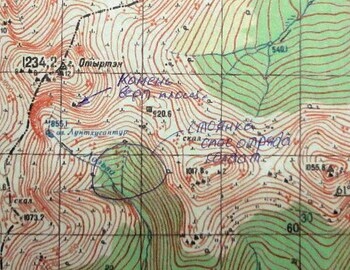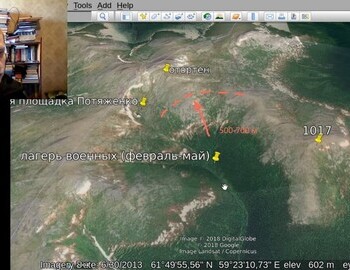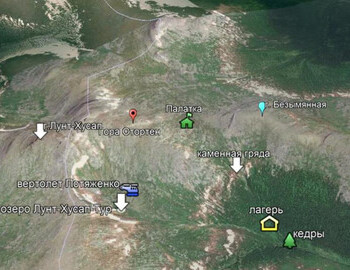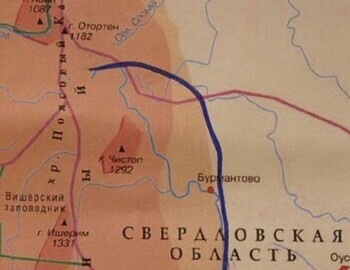
Questions to Victor Vasilyevich Potyazhenko
March 20, 2014, Vladimir (taina.li)
I - Irina (interviewer) VV - Victor Vasilyevich Potyazhenko MI - Margarita Ivanovna Potyazhenko
I: Victor Vasilyevich, where were you born?
VV: Born in Azerbaijan, city of Karadamly(?). March 6, 1933. Lived there before the war. During the war I moved to Krasnodar.
I: How did you get into aviation?
VV: In Krasnodar I studied at school and joined the flying club. I flew on gliders there. There was a glider A-2. And a plane PO-2. So I graduated from the first year on the A-2 and parachuting, that is, on a glider, and the second year on PO-2 aircraft and parachuting at the same time. Well, when I was skydiving, I was still at school. So I made my first jump, came to school, I was like Yuri Gagarin. No one jumped then, they had no idea. And suddenly I'm walking around the school alone, having a parachute jump. Everyone was staring at me. And then another friend of mine jumped and we started sharing the attention. That's how I got into aviation, graduated from flying clubs. We usually had a lot of flying clubs in the 50s. We were sent to military schools. But our Krasnodar flying club, as a rule, prepared for the Armavir school - this is a "fighter" school. Well, I didn't get there. I went to Pugachev, Saratov region. They told that there will be some new technique and I could master it. And in the city we find out later that there will be helicopters. The cadets were not told, they said it later. School entrance exams... We were told that we will fly helicopters, but that it was a secret matter, not to tell a soul, not to write to anyone about it. So even if I took notes for myself, instead of helicopter I draw a square. They were afraid, the boys were. KGB was everywhere. The letters were opened. We knew that all cadets are being watched. Well, that's how I got to this school, and then we a lot of people came to the school, a lot. But only 100 people were selected - only those who flew gliders were trained on airplanes. And they wanted to teach us how to fly helicopters in one year. Well, due to the fact that, apparently, the industry could not provide enough helicopters, instead of graduating we went on vacation, and after the vacation in the second year, we started studying. We graduated from college on the second year. And that's how I became a military pilot, a professional helicopter pilot. From there, after college, I was sent to the Transcaucasian Military District, in Tbilisi.
I: What year was that?
VV: It was in 1954. I graduated just before the New Year, I spent New Year at home, and already in 1955, therefore, I went to Tbilisi, and Tbilisi sent me to the Telavi airfield - there are 130 kilometers from Tbilisi. There was an airfield in Alazani valley. The place is wonderful.
I: And when were you appointed to Aramil?
VV: I first came to Georgia, served there for two years, and then a helicopter pilot was needed in Sverdlovsk. I was sent there with a crew. Well, without a helicopter, just me and the onboard technician, and the navigator came later. I arrived there in January, I believe it was 1956. So many years have passed, I maybe getting the years wrong. I was in Aramil until the 1961.
MI: Until 1963.
VV: Yes, until 1963. See, I got confused. The squadron where I ended up was called "Separate mixed aviation squadron". There were transport planes, we had a bomber, AN-2, Yak-12, PO-2 were still there. And there was my helicopter. There was a helicopter for me.
I: If we are talking now about the search operation in February 1959, how many planes and helicopters participated in total?
VV: Everyone is asking me now this question and I read in this book (the title of the book will be given later. Note: Irina) a lot of people participated, even, it turns out, before my flight there, but I didn’t know about it at all. I only know that when we received a call from the Operations Department that we would need to fly to Ivdel, to get a helicopter ready, an AN-2 and a Yak-12 aircraft. I'm already asking for the AN-2 too ... if it was available ... The order said: "General Gorlachenko will fly with you." Gorlachenko was the Chief of Staff of the Air Force of the Ural Military District. Big figure. I thought if he is coming something must have happened there.
I: By the way, were there any rumors at the headquarters at that time? About the students? Haven't you heard?
VV: If on a holiday an emergency happens in the district the officer on duty will know that there will be an urgent takeoff to fly somewhere. The area is large, this district stretches from Kazakhstan almost to the North Pole. From Kazan to Tyumen it was covered very well. The soldiers will definitely do something. In the middle of the week they are supervised, but on weekends everyone is gone. Either they go AWOL, they get drunk, they start a fight, someone dies. But for a general is fly, we are dealing with major emergency here.
I: Were there any rumors about missing students?
VV: I don't know, there were no conversations. The general must have known, but I didn't.
- 2 -
I: As for the crews, could you name them?
VV: I can. My flight engineer changed every time so I might not get all their names right. I was in command of the crew. Misha Novikov was the first to fly with me, Mihail Novikov. He was considered for the position of a flight navigator. Well, in a military crew, he was the navigator. And there was a flight engineer. In my opinion, either Potyagov or Nemyko. They flew for the first time. This was my crew. At that time I was still just a helicopter pilot. No, I was already a flight commander. During these two years there... Before that, in general, there was only one helicopter pilot in the entire district. For training or something else - I was the only one with a helicopter. And then when they made a squad - it was called "Aviation search and rescue squad" - there were three helicopters and a whole medical platoon. In general, I had more personnel than in the entire squadron. Two surgeons, two therapists, probably three paramedics, orderlies - in general, a lot. I was a flight commander, but I flew as a crew leader.
I: In the Maya Piskareva interview, you said that the helicopters were different. You said: "Ten days. A helicopter generates its own resource, I fly on another." What resource did you mean?
VV: I meant... When I fly... There is a special schedule. Let me give you an example, after 10 or 15 hours of flight time, not just this one but my helicopter, it needs maintenance. Change oil, drain the liquid, tighten it, replace a part if needed. This is a requirement and can only be done at your base. There we had the technical and operational unit. Specialists were there, they specially came and unscrewed and screwed everything necessary. Because there are places where the on-board technician doesn't even have the right to touch. This should be done by a specialist. That's why you're flying for 10-15 hours. The flight technician was telling me: "Vasilyich, we can only left with hours to fly to Sverdlovsk." Well, I'm applying for it tomorrow, I'm getting the workout in Sverdlovsk and back. The flight is approved. We fly to Sverdlovsk or Aramil (they are nearby). We arrive at the airfield, I leave this helicopter, we go to sleep, rest. The next day, another helicopter is ready for me. We board, fly, say, to Aramil. Once there we are told what the task. We fly back and forth. If the flights is let's say 5 hours, then the technician can do some work, but let's if it's 15 or 20 hours, then this must be done at the base.
I: Do you know the name Spitsyn?
VV: Spitsyn?... Is he the head of the flying club?... Spitsyn, the name is familiar, but I have no idea who he is.
I:Did prosecutor Tempalov fly with you?
VV: I didn't know anyone by name, and I don't know now. They asked me, I don't know. He flew with me from Ivdel to the place where I landed in the mountains, the investigator and the prosecutor flew. Once they, in my opinion, even flew together, but which of them was the prosecutor, who was the investigator? In winter, they are in such caps, everything is closed from the wind, from frost. They didn't talk to me. They are whispering among themselves, it didn't concern me.
I: Where was an emergency landing and refueling possible? And - was it done when you flew to the pass?
VV: I didn't have to. It had enough fuel on board to fly back and forth several times by helicopter. I had a 900-liter tank (970) and I also had a special tank in the helicopter for another 800 liters, so... I had enough for 5 hours of flight.
I: Whom did you carry in the first days and what was the purpose of these flights? And when was it?
VV: We flew there on the 24th, in my opinion. Yes, we have a ban on aviation (about flights on February 23 - note: Irina) We arrived on the 24th. Well, apparently, on the 25th, now I don’t remember the details - apparently, on the 25th. We flew in with Gorlachenko. Gorlachenko himself flew around this area on a plane to check from the point of view of security. He flew in and said to me: "So, comrade senior lieutenant, the area is safe, you can fly there. Make your own decisions and complete the tasks, you have permission." That's all, and he flew away. Nothing more. He told me: "If there is a need, call me at the headquarters, and we will decide with you how to proceed."
I: Was anyone else taken there in the early days?
VV: In the early days ... Ortyukov was the senior, a senior teacher, in my opinion, or the head of a department from the Polytechnic Institute, the military department. He was the eldest there, apparently - because all instructions came to me from him.
I: He was senior until February 28-29.
VV: Yes, maybe, in general, he was, then on the first day they flew with me there to the mountains, he said - we will fly now to the mountains, we will see the area - where and what, well, at the same time, - he says, - we will take with us... there were search and rescue dogs, or service and search dogs, they are great.
I: And how many were there?
VV: There were two of them. It was a terrible sight, and kind of funny, but in fact, when we saw that they didn’t want to get out of the helicopter and snarled, fear snuck up on us.
- 3 -
I: How do you explain this?
VV: Well, apparently, there was some kind of smell, there might be some kind of small vibration on the ground that a person does not feel, but they did. They got out of the helicopter - the cynologist pulled them out, they pressed right against him, their tails between their legs, their ears lowered and they won't let him go anywhere. He barely took them to the tent, and there the dogs went crazy. The cynologist flew with the dogs, then, the prosecutor, in my opinion, or the investigator - probably the investigator at the beginning, and three more people from the search group. Three because there was the cynologist, another one carrying a box (later I thought it was a radio station), well, there were also one or two more - soldiers, they were all in black sheepskin coats - you can't tell one fro the other. And you can't tell from their faces whether they're old or young. It's cold, they're all closed-tied up. So, I flew there with them. Ortyukov was with me. He said: "I know this area, let's fly, I'll show you." Well, the area is simple. There, on the map, you fly up along the ridge, then I outlined where you turn left and go straight to those mountains.
I: By the way, can we see this route on the map with you?
I: Victor Vasilyevich, do you know when the Dyatlov group was supposed to get in touch and they didn’t?
VV: People say differently. I have not been to a single meeting, or to summing up the daily results. Well, there were all sorts of conversations. I was not up to date.
I: Do you know when the search began at all and who brought the searchers to the pass?
VV: So you see - I flew there, I thought that I would fly first with Ortyukov, and then he tells me: "We already have two parties there, they have already begun to search." From what date, I don't know. In short, there was already a ground party there when we flew in. Maybe not one, maybe two, I don't know. But I didn’t fly anywhere with other parties. I flew there, it is very difficult to land... Because such an steep descent. A helicopter can fly down. I sort of chose a point such that there was a horizontal platform and sat down.
I: When you arrived for the first time the landing site was not ready. Where did you fly off to wait for the clearing to be completed?
VV: I didn't fly anywhere. We flew in, I dropped off the dogs, dropped off people, this one took the box - then I realized that apparently there was a radio station in it and they went like this, if there is a mountain here, this rock... This is where the forest is, and there is a camp set up - they sawed off the trees for me in advance spruce, birches... - they sawed them out completely so that I could land there. But the fact is that when I flew there later with Ortyukov, to see what was there, I say that I couldn't land there, because the clearing was not big enough. I said that I need another 10 meters to the left and right, and I will come in for a landing, to completely cut down the forest, so that I don’t get hooked. And I think to myself - they will cut down here for at least a month - there are so many trees here. I have a helicopter with a span of 30 meters, and I need 50 meters, 10 meters more to the left and right so I can maneuver. I think - well, they will be chopping for how many days. In short I told them what they needed to do, but I had to do what I can in the meantime. Ortyukov said "That's it, we are freezing, we had seen enough, we are going back. We flew home, that is, to Ivdel. And when we started to return home, who is needed there - the investigator, Ortyukov, my crew - launched the helicopter and flew - well, when accelerating... he must run forward, so that he could accelerate the speed so that I could fly... We are began to accelerate - and already lifted 50-70 meters, I look ahead I told Ortyukov: "Look, there is something like a tent." He saw it and said "Yes, yes. But you can't land there." For some reason it was clear there - the snow was exceptionally white, no one had been there - and poles are sticking out, it was clear that people left them there. Because they were... they seem to be arranged in a square. And the tent - it seems to be gray, faded by the sun, or in general it was so worn out that you can’t understand what color it is. Covered with snow. But Ortyukov said "Go home, let's go home." So we took off.
- 4 -
VV: And there the day is short in February, it is necessary to fly home, and the frost was severe. When we arrived he said "That's all, go rest, tomorrow we will figure it out and do something about it." A day or two passed, he called me in the hotel where I stayed, said "Come to the airfield, we will fly there." We flew. When arrive, and he said to me "The people who were in the tent cut down trees to clear the forest, and more guys joined, other people (I asked "How many people are there?" "Yes, he said, there will be enough people") to check if this was a tent or something esle. It turns out that the radio operator brought the radio station, and Ortyukov talked to him. He told him what we saw on takeoff, 500-700 meters, or maybe even a kilometer, along the way, there is something that looks like a tent. He said "If you find it, don't enter the tent, don't touch or trample anything. If there are bodies, don't touch them, do not turn anything over." And he said to me "Yes, they went where I told them and they found there some kind of tent. In addition, down, if you look maybe 200 meters down the slope, they found three corpses lying, three students."
I: When, what day, do you remember?
VV: Well, when we arrived, on the second or third day they went to look for a tent and they found these three.
I: That is, in one day - the tent and the corpses?
VV: Yes, at the same time. Well, they found the tent, then they see that it is torn apart and look down - it seems that there is something there. You know, it's so easy to say, but such a steep descent - with snow, and the length is still ... It's scary to walk, you can even fall down and crash there.
I: Were the bodies covered in snow?
VV: No, they were just lying like these... you know... like sculpture knocked off its pedestal...
I: So they were visible?
VV: Yes, that's how they lay.
I: How many times have you flown to the slope?
VV: To this area? Well, 15 times, maybe 20.
I: At how long did the helicopter stay on the slope? One hour, two, three?
VV: I usually didn’t stay there for a long time, because there was nothing to do, well, just flew in and just sat there.
I: Didn't you sleep there?
VV: No, I didn't stay overnight. I will arrive and drop off people there, I will take others back or bring food there. They will pull out the products for now - I don’t help them carry them. Well, we're flying home. And we are waiting for Ortyukov's command - what he will say.
I: What was the base camp of the searchers? How many people, were they military or civilian?
VV: I can’t help you with this, because I didn’t see it, I don’t remember. The only thing I did was when I flew there in April, I think that I should at least go and see what kind of camp they have there. All these times I never saw it. So I finally mustered up the courage to go down the path. There was a lot of snow there, but the soldiers were already walking up and down and trampled it so hard that it was already possible to go. I went downhill, I looked - the tent was, perhaps, bigger than this room. Pipe, stove. I looked, it was livable. How many people were there... Well, they were all gone to work. Some with a shovel, some left somewhere with something.
I: On the discovery of the Dyatlov group tent, what do you think, who was the first to find the tent? You? Or students? Or the search party? Civil aviators?
VV: I'm not sure. I can't say that I found, how do I know no one else has been there before I saw it? Well, who knows. I just saw it, pointed out to Ortyukov "See?" He nodded. And then when we flew there on the second, third, and so on day, when they said they found corpses there too... I thought they went to look: Ortyukov, the investigator, there was someone else, I thought I would follow them. I was curious. They didn't say anything in front of me, they just whisper among themselves. I didn't think I should interfere. Well, they went there, and I follow. The investigator went straight to the tent, looked, said "No one walked around the tent."
I: And in what condition was the tent - was it cut or not? Was it covered with snow?
VV: It was covered with snow and the poles were sideways like that.
I: Covered in snow completely or partially?
VV: No, about one third. The poles were bent. Now they say there were ski poles, but I don’t even remember if they were ski poles or not.
I: Was it cut or not?
VV: It was cut, but I cannot say whether it was cut or torn. The investigator said that the tent was cut in one place. And when I put my head in there, I see that it’s in three or four parts... The rags hang out, it’s hard to say.
I: When you were at the tent, did you see a camera with a tripod?
VV: No, I didn't see camera. I saw there... I saw - there was some kind of pot or cup... in the tent itself... I thought there was some kind of piece of sausage... the bread was lying... and there was a flask. The flask smelled of either alcohol or vodka - it smelled of alcohol.
- 5 -
I: To see all this - did you have to somehow open the tent or was it visible?
VV: And why, I approached it, the corner was dangling, flutters, I stuck my head in, not inside but closer ... You could see everything, the sun was shining, I saw it. And there was a leaf glued to the wall.
I: Was it a combat leaflet or an action plan?
VV: As far as I remember, it was written there by hand "Combat leaflet". I also remembered why - I thought that, in the army we had a combat leaflet for every day. And then the students went, for a whole month they walk and hike, and also have a combat leaflet?
I: What about content? Were there drawings?
VV: No drawings. It said "Combat leaflet". Then "Evening Otorten". Well, it was handwritten. Apparently, they wrote on the knee or on the mat... with a pencil. There were 5 or 6 holes in one letter. Well, the only thing I remember: "What we did today" or whatever ... "The task was completed" and "Plan, or tasks for tomorrow". Well, it’s already finely written there, so you won’t see it from afar.
I: Why do you think after Sharavin and Slobtsov examining the tent there was still an untouched layer of crust on top of the tent?
VV: When did they examined the tent?
I: Students Sharavin and Slobtsov examined the tent on February 26, and not just examined it, they made additional cuts on the wall so that they could see inside.
VV: I didn't know about this.
I: The crust layer was not touched on the tent...
VV: I can't say, I don't know. I thought it was the investigator who opened it.
I: Have you approached the cedar personally? Down?
VV: The one in the ravine? No, I myself did not come up these days. It was already in May when the last bodies were taken away. I flew in, I think - I just need to go and see where they are... the corpses were lying. There was a big cedar or spruce tree. That's when I noticed that they changed color. Their crowns were covered with snow when we arrived in February. I didn't go there all the way. Well, it was covered with snow. And in May when I arrived and went down it was clear that the tree is of this color, and the crown is another color (various shades of green, - note Irina). The trees changed color right on the edge where the snow was. Not only on this cedar... on all the spruce trees, everywhere.
I: Did you notice in March if the snow was somehow melted somewhere? Or the trees a little burnt?
VV: No, I didn't see it. When I went there in May, there was talk that there was a fire ... the students lit a fire there... down when they were sitting... They broke off green branches, set fire to something. And there, someone in a torn jacket or what he was wearing was fanning... burnt... The investigators concluded that, apparently, the fire died, they stopped fanning. Well, I looked - really there were logs... sticks were lying around. Charcoaled. It was a campfire, it's not from another thing. Just from the fire.
I: About the broken heel: Were there any socks on this corpse?
VV: Yes, the heel was in the sock. Something broke off, crunched, let go, I look - it hangs. Gotta glue it on. Such a big piece.
I: Do you think it was indeed part of the body or, maybe, ice?
VV: No, no, it was a part of the body, because if the leg goes like this... like this - the foot... And if you break off a piece, it turns out, as it were... it becomes even. The form is like this... it was broken off here. And then the sock, and it holds.
I: The broken heel - remained in the sock?
VV: In the sock, of course.
I: Do you remember when this corpse was carried?
VV: For the second or third time... Yes, the second time we flew. I don’t know the date - either the 25th or the 26th - that’s when we loaded it into the helicopter.
I: Where was it found?
VV: This is how they ran down from the tent ...
I: That is, is it still a slope?
VV: They either ran there and fell, or they climbed up. They say that they were going up, because everyone turned their heads to the tent.
I: A corpse with a broken heel, outstretched arms were mentioned. Were they extended over the head or over the chest?
VV: Well, like that...
I: That is above the head, not on top of the chest?
VV: I think they were all face down. It seems to me so.
I: Igor Dyatlov was found face up. Here he just had his arms bent at the elbows up (on top of his chest).
VV: But when was he found - was he in the first group?
I: Yes, in the first group.
- 6 -
I: In the area where the tent was found, дid you see any unusual phenomena in the sky at that time - lights? Did you see any strange objects?
VV: No, I didn't see anything. We were there during the day. Day light. We flew only in good weather. In bad weather, I did not even try to fly. It is difficult to fly there even in good weather. And in a difficult one - you turn your neck and won’t notice.
I: As for the footprints the Dyatlov group left themselves, leading from the tent (below) - did you see these traces yourself?
ВВ: Yes, I think two or three tracks. But it's hard to say. The investigator said, here are all nine people, nine tracks. Well, I followed and looked. I thought where does he see them? You know how is there? The mountain is bare, bald, there is no land there. Compacted snow lies only in some areas. Somehow caught on, did not slip. Then again bare ground. Then lower again 15-20-30 meters of this thin snow lies like a crust. He said that all nine tracks are there. I followed and thought - where does he see it? I may have seen two or three footprints there.
I: What type were these tracks? Recesses or not?
VV: Well, how can I say ... The depression was small - maybe a centimeter and a half, no more. It was all covered in snow.
I: So they didn't rise? Did they rise or deepen?
VV: No, they went deeper.
I: That is, there were no elevated tracks?
VV: No no.
I: Victor Vasilyevich, please take a look at this photo:
Here you can see the footprint of a bare foot, and it is covered by a footprint, apparently of a heel. Please tell me, what kind of shoes did the pilots have?
VV: We all went in high fur boots (unti).
I: Do high fur boots have heels?
VV: Well, about half an inch.
I: Do you think it could be a trace of high fur boots?
VV: Interesting question... I can't even figure out what this looks like here...
I: Does it look like a heel mark? Could it be that this is a trace of one of the helicopter pilots?
VV: Doesn't look like shoes at all. I doubt. We walked - there was no trace left - the ice was hard.
I: Namely, in the place where the snow was?
VV: Yes, I say that I was surprised how the investigator determined where all these 9 people were, because I saw two or three there. And I myself walked, and then returned, and I think: where are my footprints? They are not visible at all.
I: An article from the "Pro Gorod" newspaper said: "We looked at everything and discussed it. And then everyone went down, along the hill of the mountain with a steep slope." Please comment - what does "steep slope" mean - how many degrees?
VV: About 50-60 Degrees. Steep.
I: And 50-60 - was it all along the slope? Was it somewhere, for example, 30 or not?
VV: At first where the tent stood the descent was about 10 degrees. Then went on 15. Then after 50 meters chnaged abruptly. Maybe 60 is too much, but it was definitely at least 45 degrees.
I: And when they walked along the crust, did it push through?
VV: No.
I: In an interview with Maya Piskareva, you said: "I thought there might have been some kind of explosion. Thermonuclear..." Why did you draw such a conclusion?
VV: Thermonuclear? I never said that. I said that if there were students in this tent who studied at the "nuclear" faculty, and they only could know how to act during the explosion. Atomic. Usually the masses of students, they are... well, like an ordinary virus... that is prepared for this... salvation... They read the newspaper, saw the picture, watched TV ... but students should be taught specifically. Well, maybe all the students were not taught this, but the "thermonuclear scientists" were probably told how it happens. At first, that is bright illumination, then follows the shock wave, then comes the radiation. This is how we studied. If they saw at night an explosion that occurred somewhere, some kind of bright glow, and one of them shouted "Brothers, guard, now there will be radiation or a shock wave." If there is a shock wave, it will carry this tent somewhere beyond Otorten. Well, they apparently jumped out and ran for shelter - in the gorge - there is nowhere else to hide. But the fact that there was an atomic explosion - I did not say.
I: What do you think was the cause (of the death of students)? Your version?
VV: I thought to myself that of course they saw, apparently, some kind of explosion... they didn’t hear, - or maybe they heard... it happened in the sky. And indeed, as I said - out of fear - you need to save yourself - they all rushed down. And in order not to untie the tent, as they were sitting, who had a knife in his hands - immediately slashed, and rushed to run.
I: And what do you think might have caused the explosion?
VV: Hell knows. I don't have the faintest idea... Maybe someone blew something up. But at that time, the conversation was that geologists did not carry out any survey work anywhere, did not blow up anything.
И: And by the way, did you see any holes on the pass?
VV: No. I didn't see anything.
- 7 -
I: Let's get back to the discovery of the bodies. How many hikers were found and when? And what gender were the corpses? Do you remember?
VV: I remembered then, but I don't remember now. I don't want to lie to anyone. Well, on the first day we were three people ... I saw what they brought - they were lying on the ridge.
I: And the footage from the tent - what was the distance to the first body, to the second, do you remember?
VV: I can say approximately. From the tent to the first corpse, there were about 250 meters. But I have already said this many times, I could be mistaken. 250-300 meters maybe. Between the first and second there were about 100-150 meters. And the third also lay at the same distance.
I: As for discovering the rest?
VV: The rest were discovered later.
I: No, this is the last four. At first five bodies were found.
VV: Three were found. It seems to me that later I transported two more. I don't remember now. The first time we flew three - I remember that for sure. And then I was only responcible for transporting people back and forth, transporting products. Well, I remember, in the second run, or something, I brought a stove, a big one. I went down in the forest into this... into a hole cut in the forest. And the corpses of students... Once we took three, I took them away, and then, in my opinion, two weeks later, or maybe three more, there were two more.
I: The corpses were immediately brought into the helicopter? Or did they lie somewhere first?
VV: They lay on the mountain.
I: Near the outlier rock?
VV: Yes. They lay there. We sat down, into the cabin (? - note: Irina) began to load. Brought them in. But they are like ... you can’t bring it in... they are frozen. They barely fit into the cabin, we put them there.
I: Did you wrap them in something?
VV: No. That's how they were... We took them by the hands, by the legs...
I: And there wере no spruce branches?
VV: No, there was nothing. That's how we took them, naked, in what they were dressed, and carried them. There weren't even rags. And we brought them to Ivdel. Unloaded at the airport.
I: Could there be grass, small debris or some things from what was transported earlier in the helicopter?
VV: No, it's impossible. After we pulled out the corpses the a flight engineer... swept everything with a broom so that it is clean. If there were any debris, they swept everything away.
I: The "Pro Gorod" newspaper was published "After a few more days from the moment of the first "finds", the body of a woman with burnt clothes was unearthed"...
VV: This very piece of clothing was used to fan the fire.
I: Where was exactly this body found?
VV: In the ravine at the very bottom.
I: In a ravine? And when was that? In May? In March?
VV: Who knows... Apparently, in the first days when they got there, they began to do something: they were cold, it's freezing, they decided to warm up. And how to warm up - you can only make a fire. So it was in February. They tried to warm up.
I: Do you remember if the hikers' clothes were clean or dirty?
VV: Well, what do you mean dirty... Of course, it was not pristine, but there were no pieces of dirt on them, there were no fuel oil stains there either... Usual - grayish, black clothes.
I: They say that for a long time they did not want to load the bodies into the helicopter. Do you know why, whether there was a smell, or because the bodies were decomposed?
VV: This is the first time I hear about this. Only I transported, no one else transported by helicopter.
I: Here I mean the corpses found in May.
VV: Anyway, only I transported them, no one else. I don’t know... there were no complaints from my side. Loaded them and that's it.
I: And in May you were there alone too? No one else helped?
VV: No one. In May I finally decided to go down in the ravine to see with my own eyes. Why I was interested ... there, you know, there was such secrecy... I think - until I see it myself - I won’t understand anything. So I went down in the ravine where the last corpses were... There I noticed the color of these trees is different where the snow had melted... And something else surprised me - the soldiers that I transported, one of them said: "They found the students in the water, the corpses lay in the stream." But they were drinking water from the stream.
I: Did they take water downstream or upstream?
VV: The water that melts from the snow everywhere goes into the stream. I thought that these were the students to whom I brought the stove. I was thinking - where can the stream be, because there is a drop here and there is no accumulation of snow. I asked - which stream? And they said to me - not here, there is another group. I was surprised then, I knew that there was only one group. And there was still another group - looking for something. They were just there at the source of Lozva, and they found these corpses, two or three, in the stream that flows into Lozva, at the beginning of the source. One was there, maybe still in the water. The rest were already on the ridge.
I: And how many corpses were found in the ravine in May?
VV: Once I think - there were like four, and the second time I think - there were maybe two.
I: But this second camp of searchers - where was it located?
VV: I don't know, I didn't fly there. Somewhere to the north. To the north there is a descent there, then a hill rises again (sloping) and I was behind it, but I didn’t fly and drop off anyone there and didn’t take anyone from there. Maybe they came here from there - it's possible.
I: The photo in which the aviators are standing near the helicopter - is this photo related to the search?
VV: This is my crew.
I: And the summer photo - where are the two soldiers near the helicopter? Does it have anything to do with searches? Let's see the album (recording cuts off).
I: Were you questioned after that?
VV: No one interrogated or questioned me.
I: Did you sign nondisclosure?
VV: No, I didn't sign anything. I was here - they came already from television, they asked - did you sign a non-disclosure? I said that I did not sign anything. I took the oath at the time, that's all. And they said on television that we all signed a non-disclosure.
- 8 -
Questions to Margarita Ivanovna:
I: Margarita Ivanovna, did you work as a radio operator for civil aviators?
MI: Yes, civilians. At the Ivdel airport.
I: Do you know when the military aviators were given the task of starting the search? Maybe some radiograms?
MI: No, my main task was: the plane took off somewhere.
VV: She could have been informed, for example, that my helicopter took off from Aramil at so many hours. She will hand over to the dispatcher, nothing more.
MI: The main thing was the weather. Well, what else was passed there - I don’t remember anymore.
I: And when did you get married with Victor Vasilyevich?
VV: In 1960. In a year.
I: Do you remember the numbers of the radiograms that were broadcast then? Most likely not anymore?
MI: I didn't pay any attention to it.
I: What about the content of the radiograms that were transmitted at that time? What were they about?
MI: I remember receiving one radiogram. It was on April 23 or 24. From Mt Otorten - radio operators were stationed there. They reported that a "rocket had landed" there. What kind of rocket landed here, it said. I asked Sverdlovsk - there were no rocket launches in that area. This was the text. The commander said the soldiers fled. They collected them later. Scared. What rocket? Maybe a whole cigar. They say this now, but then they didn’t tell us anything.
VV: At that time, there was no UFO in the press, anywhere. It may have existed, but the people did not know. And we didn't know. And then, when 30 years have already passed, I think - maybe a UFO actually flew there somewhere. This is later, after 30 years I thought. And then - for 60 years, I see, no one asks about me, so there was nothing there. What angered me on TV in this program where they didn't mentioned my name, but the name of Patrushev. Patrushev and Patrushev's wife. What does he have to do with this search? And then I found this book "Secret..." "Death stamped Classified"
I: "Stamped Top secret"?
VV: And it was written about this Patrushev - where he studied, how he arrived, with whom he flew. He flew on the Yak-12. You can’t land anywhere on the Yak-12 in the mountains, you can’t take anything. Well, he says when he flew to which mission, there were landings, he landed on the landings. But this is not connected with this period, but simply before. He talked with local residents from the village, was interested in how the groups pass, do not pass. Are there trails? What he wanted, who knows. It says here that he was there, in those areas. But now the sites that used to be for aircraft are small, they are no longer used and are not being operated. Apparently overgrown. Therefore, they called - when will this stop - the talk about Patrushev's involvement... Then our local press arrived. And from Moscow, from television. I told them this too.
I: Margarita Ivanovna, have you ever been on the slope?
MI: No, I haven't been there. Grandpa here took me... where did you take me? :-))))
VV: I took her there.
MI: To the policeman.
VV: I don't even know where I took my wife. :-))))
MI: I was with him - we were sitting in a helicopter, and it was so cold. Then they brought me a pike. Baked.
VV: And we ate mostly stroganina with bear fat.
MI: In this village, I saw a pillar - and a human head was carved. I don't remember anything else. There I was with this policeman.
VV: She visited Kurikov.
I: The newspaper "Pro Gorod" said: "One of the days during the search I heard: a rocket landed on Otorten." What do you mean by "landed"? - fell unscheduled, emergency? Or planned?
MI: I have no idea. I sent it: pass it on to Sverdlovsk. Some general was sitting: send it to Sverdlovsk urgently. I sent it to Sverdlovsk, Sverdlovsk said that no missiles had been launched into that region.
VV: When I was there on April 1, and I, in my opinion, went down to the tent. Or they were at the top... He said: at night we had an alarm. All the soldiers jumped up, almost stuffing each other's noses. The orderly sat, read at night, kindled the stove, and read some kind of magazine, then looked - the sun was shining so brightly. Shouts "Get up!" And then a soldier: Why are you yelling at such an early hour? I jumped outside, looked at the sky, and there was this big "donut" hangs and shines so brightly. Then silence and darkness came. And it's so dark that you can't even see the light - that the stove is on fire. One soldier then could not find the tent for a long time. Slapped for a whole hour. And it seems, he says, I hear how the soldiers are talking in the tent, he himself began to yell - no one hears me.
(The end)
- 9 -
Now there are a few points that I would like to focus on in particular.
I did not accidentally ask the question about the place of birth. Do you remember the inscriptions in the album: "Atarten", "Artyukov"? There was a thought - perhaps Victor Vasilyevich was born in a region where they "akyut"? He was 25 at the time of the search. Perhaps it was this pronunciation that stuck in his memory, especially since it was not he who laid the route on the maps? It turned out - Azerbaijan. And now I have a question for KAME: is the "aking" pronunciation typical for the inhabitants of Azerbaijan? As far as I remember from trips to Baku, yes. But it was a long time ago, and you live there! Enlighten please.
Some questions were asked in order to understand whether this or that moment in previous publications was thought out by journalists or not (for example, a rather absurd phrase from "Pro Gorod" that "On February 1-2, a group of students had to get in touch and did not".
As for the photos: in two albums - there are actually few photos related to the search for the Dyatlov group and precisely from that time. Almost all of them have already been photographed. At the request of Helga, I asked Victor Vasilyevich if there were inscriptions on the reverse side of the photographs - it turned out that only one photograph: (see below)
Regarding the notorious heel mark: as I understand it, there were some heels on the tall fur boots. VV could walk on the slope - he could well leave that trail. So it is not serious to draw any far-reaching conclusions (for example, about the presence of outsiders), including on the basis of the presence of this trace.
The notorious slope of the mountain haunted me too. As you can see, VV stands on the fact that the slope was in no way less than 45 degrees!
Yes, of course, VV is an elderly person. Yes, it's been 55 years. Here, even at a younger age, sometimes you can’t remember what happened a month ago... Of course, inaccuracies and "overlapping" of events are possible.
As for the photo of the fetching of the last four, in which two figures in black jackets are clearly visible - I showed him the photo, but Victor Vasilyevich found it difficult to answer whether he was present in that picture or not.
I showed Victor Vasilievich two photos of the Dyatlov group tent - in one photo the tent was still intact, and in the other was the famous photo of the discovered, half-covered with snow tent (I cut off the figures on the left plan ahead of time for the purity of the experiment). I asked what photo the tent of the Dyatlov group he had seen more closely matches. VV didn't hesitate to choose the photo of a half-covered tent. For some reason, I can't hear this episode on the recorder. But I turned off the voice recorder several times when it was about a photo - after all, it is difficult to reproduce the words "this" or "this".
The photo of the outlier (aka boot) rock was taken by him.
The young man in the flight helmet has nothing to do with the search. This is a former colleague (but not Margarita Ivanovna). (photo posted below)
As for the maps, I had a few handy to clarify the route. BUT. It is clearly difficult for Victor Vasilyevich to read small text. So I ended this experiment after the first map.
In general, they are already tired of the interview, yes. Not muzzled, but already spoken out. Many thanks to Olga33. Already simply for the fact that Margarita Ivanovna said with warmth: "Olya will still come." The fact that Olya will still come is good, but I really hope that no one else will come, it’s already enough. Two middle-aged people have already done a lot for you and me.
One of my priority intentions was to "smooth out" the consequences of numerous interviews - mine, after all, is clearly one of the last. I deliberately left enough time "for after the interview" to just talk with these nice people, not about the incident but about what is now interesting to them in their current lives. And my mother helped me in this - I took her with me to the interview as an assistant. The calculation (if this word is generally appropriate here) was made on the fact that my parents are only a little younger than the Dyatlov group, that my father is also a military man. And so it happened that they had something to talk about. By the way, it turned out that my parents' dacha is almost next door to the dacha of the Potyazhenkos. Small world! They exchanged phone numbers, and the further continuation of the Marleson ballet (expression) will be without me. And I can only thank these wonderful people for their time and warmth of their soul.
From Potyazhenko's archive
You can see Potyazhenko's landing site and Syunikaev's unit 6602 camp on these maps. But take a closer look. Potyazhenko drew his landing site on a rock on the steep slope of Otorten. Semiletov and Bobrikov based their maps on the one Potyazhenko drew and gave Kuntsevich, but they moved Potyazhenko's landing site on the Lunthusaptur lake, the first place where a helicopter could have landed south of Otorten. The route on the last (simplified, no contour lines) map is drawn by Potyazhenko himself in 2014 during an interview by Irina. The route is clearly not ending on Otorten but the Dyatlov Pass. In that same interview Irina says that she had given up showing Potyazhenko other maps he can't see well. His sight has not gotten any better in four years when he circled in 2018 where he landed in 1959. Also he had taken picture of the rock where he landed and that is the rock with the monument plaque on the Dyatlov Pass. In another interview by Olga Potyazhenko clearly says that he "landed near a rock on the saddle between Auspiya and Lozva". When Potyazenko was shown a modern photo of Kholat Syakhl and the outlier rock: "here I was sitting (landed near the rock), there is a descent (points south to the Auspiya valley), in this place there was the soldier's camp..." Where did he see the tent of the Dyatlov group, he points to the Kholat Syakhl slope, "700 meters from the rock".

